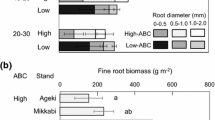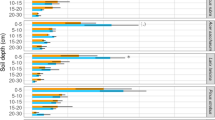Abstract
It is generally believed that high soil solution Al3+ in acidic soils with low base saturation (BS), negatively influences the properties of fine roots. Fine roots from European beech (Fagus sylvatica L.) trees growing in highly acidic soils with very low BS and potentially high Al3+ concentration in the soil solution were analysed and the dependency of fine root properties on soil BS was measured. The fine roots were sampled down to 1 m depth at seven forest sites located on the Swiss Plateau. These sites varied in their BS from 1.4 to 11.4% in the mineral layers. We evaluated relationships between the BS of these mineral layers and fine root properties, such as ratio between bio- and necromass (live/dead ratio), specific root length (SRL), root tip abundance (RTA), root branching abundance (RBA), O2-consumption, and the Ca/Al molar ratio in the fine root tissue. The fine root properties were compared not only with the BS of the soil, but also with the Ca/Al molar ratio in the fine root tissues. Significant relations of fine root properties occurred when the soils of the seven sites were grouped into two BS groups (<5 and 5–10%). The live/dead ratio, the RTA, the RBA, the O2-consumption, and Ca/Al molar ratio were lower in the group of BS <5% than in the group 5–10%. Decreases in the morphological properties and in the O2-consumption were related to decrease in the Ca/Al molar ratio of the fine root tissues. There is evidence that the fine root properties are negatively influenced, nevertheless, fine root systems of mature European beech in their natural ecological environment seem to be able to compensate adverse effects of low BS.







Similar content being viewed by others
Abbreviations
- BS:
-
base saturation (%)
- RTA:
-
root tip abundance (n g−1)
- RBA:
-
root branching abundance (n g−1)
- SRL:
-
specific root length (cm g−1)
- CEC:
-
cation exchange capacity (mmolc kg−1)
References
Blaser P, Zysset M, Zimmermann S, Luster J (1999) Soil acidification in southern Switzerland between 1987 and 1997: a case study on the critical load concept. Environ Sci Technol 33:2382–2389
Braun S, Schindler C, Volz R, Flückiger W (2003) Forest damages by the storm “Lothar” in permanent observation plots in Switzerland: the significance of soil acidification and nitrogen deposition. Water Air Soil Pollut 142:327–340
Brunner I, Rigling D, Egli S, Blaser P (1999) Response of Norway spruce seedlings in relation to chemical properties of forest soils. For Ecol Manage 116:71–81
Clemensson-Lindell A, Persson H (1995) Fine-root vitality in a Norway spruce stand subjected to various nutrient supplies. Plant Soil 168–169:167–172
Comas LH, Eissenstat DM (2004) Linking fine root traits to maximum potential growth rate among 11 mature temperate tree species. Funct Ecol 18:388–397
Comas LH, Eissenstat DM, Lakso AN (2000) Assessing root death and root system dynamics in a study of grape canopy pruning. New Phytol 147:171–178
Cronan CS, Grigal DF (1995) Use of calcium/aluminium ratios as indicators of stress in forest ecosystems. J Environ Qual 24:209–226
Eldhuset TD, Lange H, de Wit HA (2006) Fine root biomass, necromass and chemistry during seven years of elevated aluminium concentrations in the soil solutions of a middle-aged Picea abies stand. Sci Total Environ 369:344–356
Ellenberg H, Klötzli F (1972) Waldgesellschaften und Waldstandorte der Schweiz. Mitteilungen EAFV 48:587–930
Espeleta JF, Donovan LA (2002) Fine root demography and morphology in response to soil resources availability among xeric and mesic sandhill tree species. Funct Ecol 16:113–121
Fitter AH (1991) Characteristics and functions of root systems. In: Waisel Y, Eshel A, Kafkafi U (eds) Plant roots: the hidden half. Marcel Dekker, New York, pp 3–25
Gaudinski JB, Trumbore SE, Davidson EA, Cook AC, Markewitz D, Richter DD (2001) The age of fine-root carbon in three forests of the eastern United States measured by radiocarbon. Oecologia 129:420–429
Godbold DL, Jentschke G (1998) Aluminium accumulation in root cell walls coincides with inhibition of root growth but not with inhibition of magnesium uptake in Norway spruce. Physiol Plant 102:553–560
Godbold DL, Fritz HW, Jentschke G, Meesenburg H, Rademacher P (2003) Root turnover and root necromass accumulation of Norway spruce (Picea abies) are affected by soil acidity. Tree Physiol 23:915–921
Göransson A, Eldhuset TD (1991) Effects of aluminium on growth and nutrient uptake of small Picea abies and Pinus sylvestris plants. Trees 5:136–142
Göransson A, Eldhuset TD (1995) Effects of aluminium ions on uptake of calcium, magnesium and nitrogen in Betula pendula seedlings growing at high and low nutrient supply rates. Water Air Soil Pollut 83:351–361
Graf Pannatier E, Walthert L, Blaser P (2004) Solution chemistry in acid forest soils: are the BC:Al ratios as critical as expected in Switzerland? J Plant Nutr Soil Sci 167:160–168
Hertel D, Leuschner C (2002) A comparison of four different fine root production estimates with ecosystem carbon balance data in a Fagus–Quercus mixed forest. Plant Soil 239:237–251
Hirano Y, Hijii N (2000) Root system response of Japanese red cedar saplings to acidic conditions. Environ Exp Bot 44:115–124
Hodge A (2004) The plastic plant: root responses to heterogeneous supplies of nutrients. New Phytol 162:2–9
Jentschke G, Drexhage M, Fritz HW, Fritz E, Schella B, Lee DH, Gruber F, Heimann J, Kuhr M, Schmidt J, Schmidt S, Zimmermann R, Godbold DL (2001) Does soil acidity reduce subsoil rooting in Norway spruce (Picea abies)? Plant Soil 237:91–108
Kochian LV, Pineros MA, Hoekenga OA (2005) The physiology, genetics and molecular biology of plant aluminium resistance and toxicity. Plant Soil 274:175–195
Leuschner C, Hertel D, Schmid I, Koch O, Muhs A, Hölscher D (2004) Stand fine root biomass and fine root morphology in old-growth beech forests as a function of precipitation and soil fertility. Plant Soil 258:43–56
Leuschner C, Meier IC, Hertel D (2006) On the niche breadth of Fagus sylvatica: soil nutrient status in 50 Central European beech stands on a broad range of bedrock types. Ann For Sci 63:355–368
Matsumoto H (2000) Cell biology of aluminium toxicity and tolerance in higher plants. Int Rev Cytol 200:1–46
Mayer P, Brang P, Dobbertin M, Hallenbarter D, Mayer FJ, Renaud JP, Walthert L, Zimmermann S (2005) Forest storm damage is more frequent on acidic soils. Annu For Sci 62:303–311
Nygaard PH, de Wit HA (2004) Effects of elevated soil solution Al concentrations on fine roots in a middle-aged Norway spruce (Picea abies (L.) Karst.) stand. Plant Soil 265:131–140
Ostonen I, Lömus K, Lasn R (1999) The role of soil conditions in fine root ecomorphology in Norway spruce (Picea abies (L.) Karst.). Plant Soil 208:283–292
Parker DR (2005) Aluminium speciation. Encyclopedia of Soils in the Environment, pp 50–56
Paulitz TC (2002) Fine roots of trees – a new perspective. New Phytol 154:267–273
Rengel Z (1992) Role of calcium in aluminium toxicity. New Phytol 121:499–513
Rengel Z, Zhang W-H (2003) Role of dynamics of intracellular calcium in aluminium-toxicity syndrome. New Phytol 159:295–314
Richter AK, Frossard E, Brunner I (2007) Polyphenols in woody roots of Norway spruce and European beech reduce TTC. Tree Physiol 27:155–160
van Schöll L, Keltjens WG, Hoffland E, van Breemen N (2004) Aluminium concentration versus the base cation to aluminium ratio as predictors for aluminium toxicity in Pinus sylvestris and Picea abies seedlings. For Ecol Manag 195:301–309
Vanguelova EI, Nortcliff S, Moffat AJ, Kennedy F (2005) Morphology, biomass and nutrient status of fine roots of Scots pine (Pinus sylvestris) as influenced by seasonal fluctuations in soil moisture and soil solution chemistry. Plant Soil 270:233–247
Walthert L, Zimmermann S, Blaser P, Luster J, Lüscher P (2004) Waldböden der Schweiz. Band 1. Grundlagen und Region Jura, Hep Verlag, Bern
Wargo PM, Vogt K, Vogt D, Holifield Q, Tilley J, Lawrence G, David M (2003) Vitality and chemistry of roots of red spruce in forest floors of stands with a gradient of soil Al/Ca ratios in the northeastern United States. Can J For Res 33:635–652
Yamamoto Y, Kobayashi Y, Devi SR, Rikiishi S, Matsumoto H (2002) Aluminium toxicity is associated with mitochondrial dysfunction and production of reactive oxygen species in plant cells. Plant Physiol 128:63–72
Zysset M, Brunner I, Frey B, Blaser P (1996) Response of European chestnut to varying calcium/aluminium ratios. J Environ Qual 25:702–708
Acknowledgment
We thank Roger Köchli for managing the fieldwork, Sven Knollmann for providing helping hands in data acquisition, the group of Daniele Pezzotta for element analyses, the group of Emmanuel Frossard for constructive discussions about this work, and Silvia Dingwall for improving our English. This study was financed by the VELUX Foundation.
Author information
Authors and Affiliations
Corresponding author
Additional information
Responsible Editor: Philippe Hinsinger.
Rights and permissions
About this article
Cite this article
Richter, A.K., Walthert, L., Frossard, E. et al. Does low soil base saturation affect fine root properties of European beech (Fagus sylvatica L.)?. Plant Soil 298, 69–79 (2007). https://doi.org/10.1007/s11104-007-9338-x
Received:
Accepted:
Published:
Issue Date:
DOI: https://doi.org/10.1007/s11104-007-9338-x




